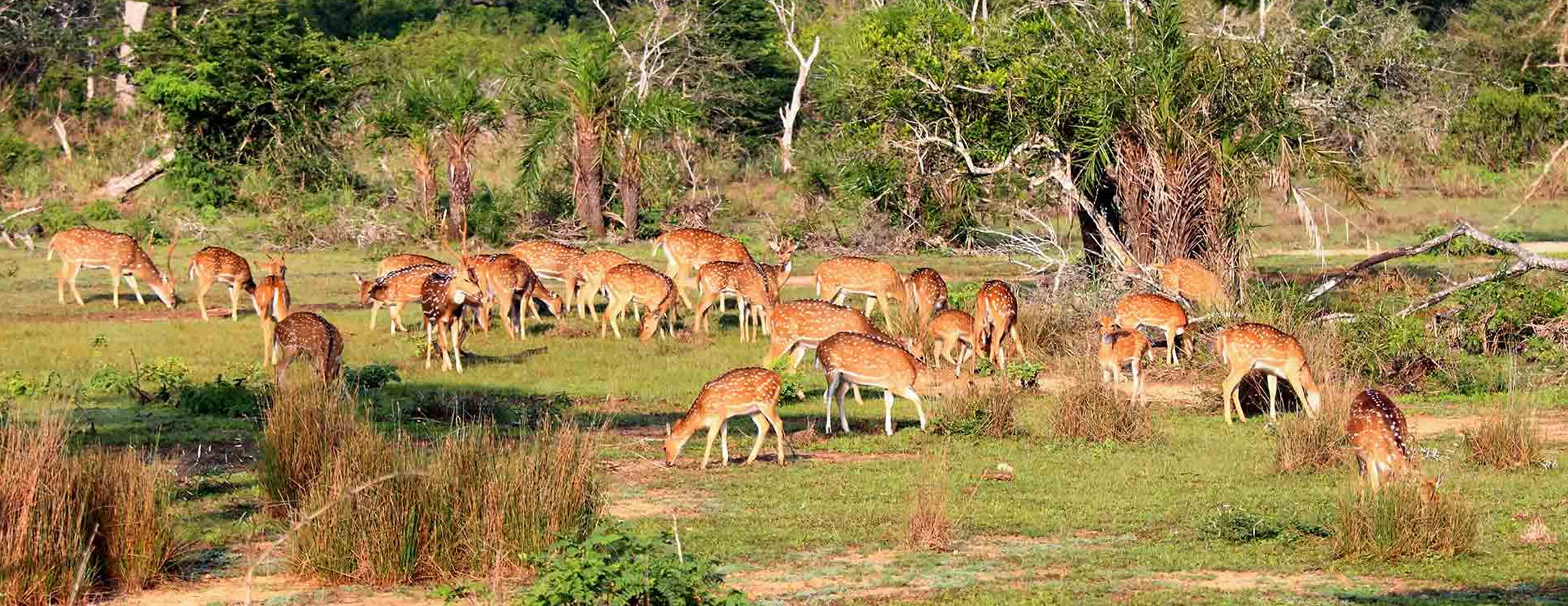Wilpattu National Park
Wilpattu National Park (Willu-pattu, "Land of Lakes") is a national park in Sri Lanka. The unique feature of this park is the existence of "Willus" (natural lakes) – natural, sand-rimmed water basins or depressions that fill with rainwater. Located on the northwest coast lowland dry zone of Sri Lanka, the park is 30 km (19 mi) west of Anuradhapura and 26 km (16 mi) north of Puttalam (approximately 180 km (110 mi) north of Colombo). The park is 1,317 km2 (508 sq mi) (131,693 hectares) in area and ranges from 0–152 m (0–499 ft) above sea level. Nearly one hundred and six lakes (Willu) and tanks are found spread throughout Wilpattu. Wilpattu is the largest and one of the oldest national parks in Sri Lanka. Wilpattu is world-renowned for its leopard (Panthera pardus kotiya) population. A remote camera survey conducted in Wilpattu from July to October 2015 by the Wilderness and Wildlife Conservation Trust captured photographs of forty-nine individual leopards in the surveyed area, the core area density of which was between that of Yala National Park's Block I and Horton Plains National Park.
From December 1988 to 16 March 2003, the park was closed due to security concerns surrounding the Sri Lankan Civil War, before being reopened to visitors sixteen years later. Visitor access is currently limited to approximately 25% of the park, the remainder of which is dense forest or scrub. Popular visiting periods span between the months of February and October, although there are a number of private ecotourism groups that conduct safaris year-round.
History
The Mahavansa records that in 543 BC Prince Vijaya landed at Tambapanni now known as Kudrimalai Point (Horse Point), established the Sinhalese kingdom in Tambapanni and founded the Sinhala nation. In 1905 the area was designated a sanctuary and in 1938 it was upgraded to the National Park status.
Kudrimalai, or Horse Point, was visited by a subject of Emperor Claudius in 47 AD, who was blown off course by the monsoon. The local king later sent his own envoys to Rome during the time of Pliny.
Climate
Marshy vegetation.
The annual Rainfall is about 1,000 mm (39 in) and the annual temperature is about 27.2 °C (81.0 °F). Inter-monsoonal rains in March and the northeast monsoon (December – February) are the main sources of rainfall.
Flora and fauna
There are many types of vegetation to be found in Wilpattu, including littoral vegetation, such as salt grass and low scrub monsoon forest with tall emergents, such as palu (Manilkara hexandra), and satin (Chloroxylon swietenia), milla (Vitex altissima), weera (Drypetes sepiaria), ebony (Diospyros ebenum) and wewarna (Alseodaphne semecapriflolia).
31 species of mammals have been identified within Wilpattu national park. Mammals that are identified as threatened species living within the Wilpattu National Park are the elephant (Elephas maximus maximus), sloth bear (Melursus ursinus inornatus), leopard (Panthera pardus kotiya) and water buffalo (Bubalus bubalis). sambhur (Rusa unicolor unicolor), spotted deer (Axis axis ceylonensis), mongoose, mouse and shrew are more of Wilpattu's residents.
Birds
The painted stork, the open bill, little cormorant, Sri Lankan junglefowl (Gallus lafayetii) along with many species of owls, terns, gulls, eagles, kites buzzards are to be found at Wilpattu National Park. Wetland bird species that can be seen in Wilpattu are the garganey (Anas querquedula), pintail (Anas acuta), whistling teal (Dendrocygna javanica), spoonbill (Platalea leucorodia), black-headed ibis (Threskiornis malanocephalus), large white egret (Egretta alba modesta), cattle egret (Bubulcus ibis) and purple heron (Ardea purpurea).
Reptiles
The most common reptiles found in the park are the monitor lizard (Varanus bengalensis), mugger crocodile (Crocodylus palustris), common cobra (Naja naja), rat snake (Ptyas mucosus), Indian python (Python molurus), pond turtle (Melanonchelys trijuga) and the soft shelled turtle (Lissemys punctata) which are resident in the large permanent Villus.
Expansion of the boundary
The boundary of the Wilpattu national park originally enclosed the Puttalam District in the south and Anuradhapura District in the east.[4][5][6][7] On October 10, 2012, the government published several gazettes (section 3 of the forest conservation ordinance, chapter 451) which effectively extended the park's boundary to include regions of the northern province.[8][9] The expansion of the Wilpattu National Park boundary in 2012 is considered a significant obstacle for internally displaced people, particularly those affected by the Expulsion of Muslims from the Northern Province of Sri Lanka by the LTTE to return to their homeland.
Deforestation
After the end of the civil war, allegations had been made[by whom?] that parts of the reserve has been occupied to build houses by certain politicians in an attempt to create Muslim colonies in Wilpattu.[11] The multiple civil societies and researchers put forth the notion that these were people who had been forcibly driven away by the LTTE in 1990 in accordance to their ethnic cleansing policy who had returned to their original villages.[12] [13] [14] Notably, the park was extended to the current size in 1999 after the ethnic cleansing where the old villages were marked as part of the park as claimed by the people in this area.[15][16] Aerial images taken in 2018 reputedly shows that a considerable portion of the forest has been opened up and a large number of small houses being built in the area.
Birds
Greater coucal
Sri Lankan junglefowl
White-bellied sea eagle
Crested treeswift
Black-winged stilt
Malabar pied hornbill
Orange-breasted green pigeon
Blue-tailed bee-eater
Asian green bee-eater
Chestnut-headed bee-eater
Green imperial pigeon
Indian paradise flycatcher
Crested serpent eagle
Changeable hawk-eagle
Black-capped kingfisher
Brown shrike
Cattle egret
Indian peafowl
Painted stork
Reptiles
Bengal monitor
Indian rock python
Mugger crocodile
Terrestrial animals
Sri Lankan elephant
Sri Lankan leopard
Sri Lankan sloth bear
Sri Lankan axis deer
Tufted gray langur



